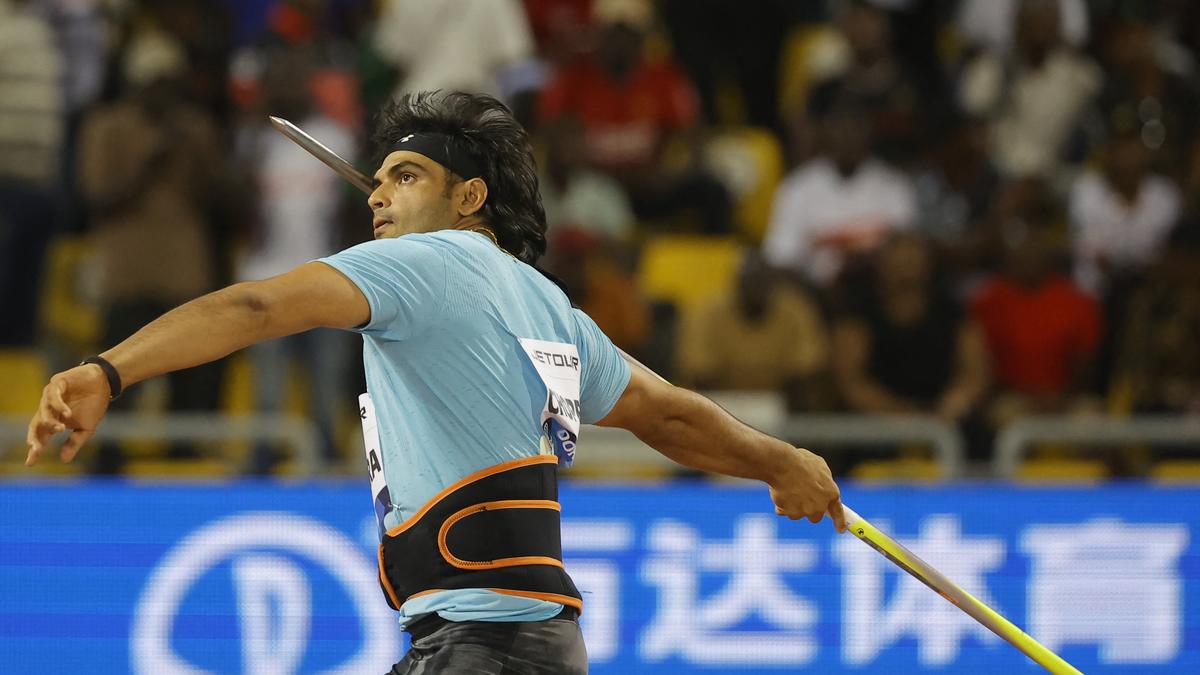Injury-free Neeraj Chopra finally breaks 90m barrier, gets the monkey off his back
On his third attempt of the competition, even as high speed TV cameras strained to frame the still-soaring fluorescent green projectile he had flung into the black night of Doha, Neeraj Chopra threw his arms up with his index fingers pointing to the sky. He didn’t need to wait to see where his javelin would bury itself on the turf of the Suheim bin Hamad Stadium. He’s spoken before of realising whether he’s made a good throw or not the moment the spear leaves his hand. Whether the job’s done or not.
His arms were aloft at the final of Tokyo Olympics where he won a milestone gold. They were raised in victory at the World Championships in Budapest in 2023. They’ve telegraphed triumph at the Asian Games and Commonwealth Games. On Friday night at the Doha Diamond League, they did so once more as the 27-year-old went into the history books.
90.23m – The digital board at the other end of the ground flashed how far his javelin had travelled. It’s a new national record (not that surprising any more considering he’s improved on it half a dozen times since he first set it nine years ago) and the world lead. But it puts him in one of the most exclusive groups in world athletics – the 90m club. Neeraj is only the 25th man to know what it’s like to throw a spear that far.
Monkey off his back
For all the magnitude of the accomplishment, the overwhelming emotion on the face of the 27-year-old wasn’t ecstasy or joy. It seemed to be the relief of getting a monkey off his back. There was just a hint of a smile as he accepted handshakes from the rest of the field. Then, back to business once again.
The first time Neeraj spoke of wanting to be part of this ‘club’ was back in 2016 shortly after he became the first Indian to win gold at the junior world championships. “My main target is to achieve a distance of 90m. That is a benchmark at world level and if I can throw that much then I will be able to win a medal at world level and also at Olympics,” he had said.
In the years following that observation, the then 18-year-old would win all the medals he had ever dreamt of. The fact that he would finish on the podium – since Tokyo, he’s never finished outside the top two of any competition – became almost inevitable. That consistency was taken almost for granted. He could win as much as he did and the question that would follow would be about that challenge he had set out for himself as a teenager, one he was yet to accomplish.
READ | Chasing 90m — Neeraj Chopra’s pursuit of the ultimate barrier in javelin throw
The 90m throw which was supposed to pave the way for his big medals, however, seemed frustratingly just out of reach. Neeraj had come close many times –there were six competitions in the last three years where he had gone past 89m but short of 90m.
At every press conference and interview he would sit for over the last seven years, including one on the eve of the Doha Diamond League, Neeraj would be asked some variation of “When will you cross 90m?”
Every time, he would answer with some permutation of “It’s a target and I’m getting close but I’m not going to lose sleep over it.”
Arbitrary number?
It’s possible that with time, the number had lost some of its hold over Neeraj. He’d make the fundamentally sound point that staying consistent and winning medals was a lot more important than chasing what was essentially an arbitrary number, just like the 10-second barrier in the 100m. His former coach Klaus Bartonietz had backed him on this as well.
“What’s so special about 90m?” – Bartonietz had once asked this reporter. It’s significance, he’d say, was simply because we measure distances in meters, base 10 is used for mathematical applications, and people generally find it easy to quantify things in multiples of 10. “If we were measuring using feet, then we’d wonder what’s so special about 295.276 feet (the equivalent of 90m),” he’d say.
Yet, as much as he’d deny, it mattered to him. It was important for Neeraj to throw this mark, if only to prove to himself that he could hit it when it mattered to him. At last year’s Olympic Games in Paris, Neeraj had once again come naggingly close to the 90m mark with a throw of 89.45m. However, Pakistan’s Arshad Nadeem had produced a mammoth 92.97m to storm to the gold.
In Doha too, despite Neeraj’s milestone performance, he was pipped to the win by Germany’s Julian Weber who threw a personal best 91.06m with his last throw of the competition. Add Anderson Peters (who came third in Doha) who has thrown over 90m at five separate competitions, including once late last season, to the mix and it seems likely that it’s going to take another throw over 90m to determine the winner of the 2025 World Championships in Japan where Neeraj will be defending his title.
Now that Neeraj has breached the 90m mark, it is unlikely that he will want to just dip his foot into this elite range and step out.
Injury free, improved technique
The best argument in favour of why this is likely to be the case was made by Neeraj himself a few weeks back at another press conference (where, of course, the 90m bogey had been raised). Back then, Neeraj had announced that he had finally recovered from the groin injury that had plagued him since 2018 when he first announced himself at the senior level with gold medals at the Commonwealth and Asian Games.
The nature of that injury in the years following the 2022 World Championships where he had tweaked it particularly badly meant that Neeraj was unable to train nearly as hard as his competitors. Every time he threw, he’d do so with the fear that he would aggravate his ailment. “Other athletes are able to train many times but I’d be able to have maybe one session a week,” he had revealed then. Most of his training was devoted to injury prevention and management before he finally decided to get surgery and fix his issue late last year.
ALSO READ | Neeraj Chopra brings on three-time Olympic champion Zelezny as coach
If 2025 is the year in which he is finally throwing pain-free, it’s also significant for another reason – it’s his first season where he has been training under World Record holder Jan Zelezny. Neeraj only has good things to say about previous coach Bartonietz under whom he not only managed his injury and became Olympic and World Champion but it’s clear Zelezny has bigger ambitions.
Under Zelezny, Neeraj has made small but significant corrections to his throwing technique. In the past, Neeraj had himself observed his throws drifting over to the left of the field rather than flying straight and costing his throws crucial meters.
Now, Neeraj’s left leg comes down to make the block (the step in which the javelin thrower stops with his left foot, forcing his body to pivot and transfer his forward momentum to propel the javelin) a lot faster than it used to. It means Neeraj doesn’t fall over to one side as much as he earlier did. He’s also holding the javelin a lot more parallel to the runway, prior to his release. This leads to lesser work required to keep the javelin on a straight trajectory. The bulk of his power now goes in sending the javelin as far as possible, down the center of the field.
None of this is very revolutionary – it’s old school javelin throw. Go through the footage of Neeraj from the junior world championships in 2016 and he’s throwing almost in the same way but only a few meters less than he’s doing now despite being significantly less stronger. It’s likely that Neeraj’s injury had caused some involuntary changes to his technique but now that that’s in the past, things have started falling in place, making the big throw inevitable.
Even though they have only been working together for a few months, it is obvious how much belief Zelezny has in Neeraj. “Normally, he does not go to the Diamond Leagues but he came with me because he told me that today is the day to achieve 90m,” Neeraj said after the competition.
Long road ahead
While he might have crossed the 90m barrier, Neeraj isn’t nearly satisfied. The fact that the barrier is ultimately an arbitrary figure was reinforced by the fact that Neeraj ended up finishing second even after making his best-ever throw. “It is a little bit bittersweet result. I am very happy for the 90m, but this second place – it actually happened to me also when I competed in Stockholm (Diamond League in 2022 where he threw a then National record 89.94m). I threw 89.94 and I was always second. And also here, I broke the national record and got second today,” he told the reporters in Doha.
He’s already looking ahead. The way he has started this season suggests that in the months to come, he’s going to do more than just touching the 90m mark, like he did in Doha.
For now, he’s at least taken one mandatory question out of press conferences. “I don’t know about me, but I think the burden of Indians (who were waiting for me to breach 90m) would have gone down! I think I can throw better and I will do better. There’s a long season and we have the World championships in September. I used to throw 89m consistently, but now I will try to go over 90m regularly. Abhi mai khul ke maarunga (Now, I’m going to throw freely),” he said.


